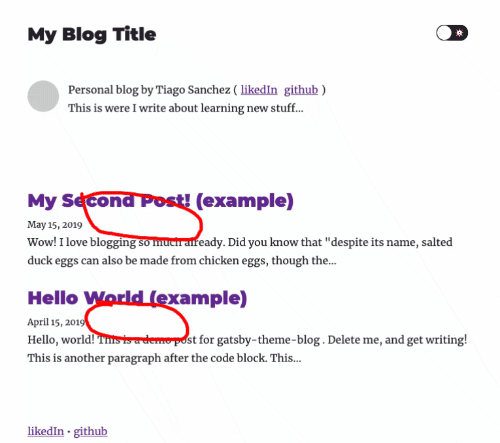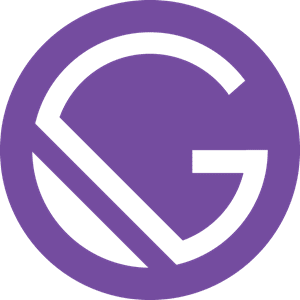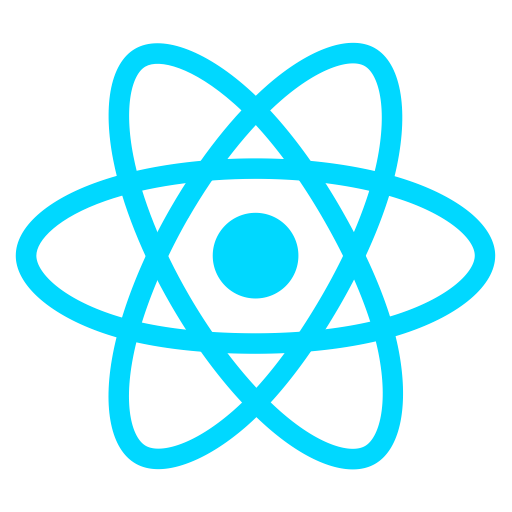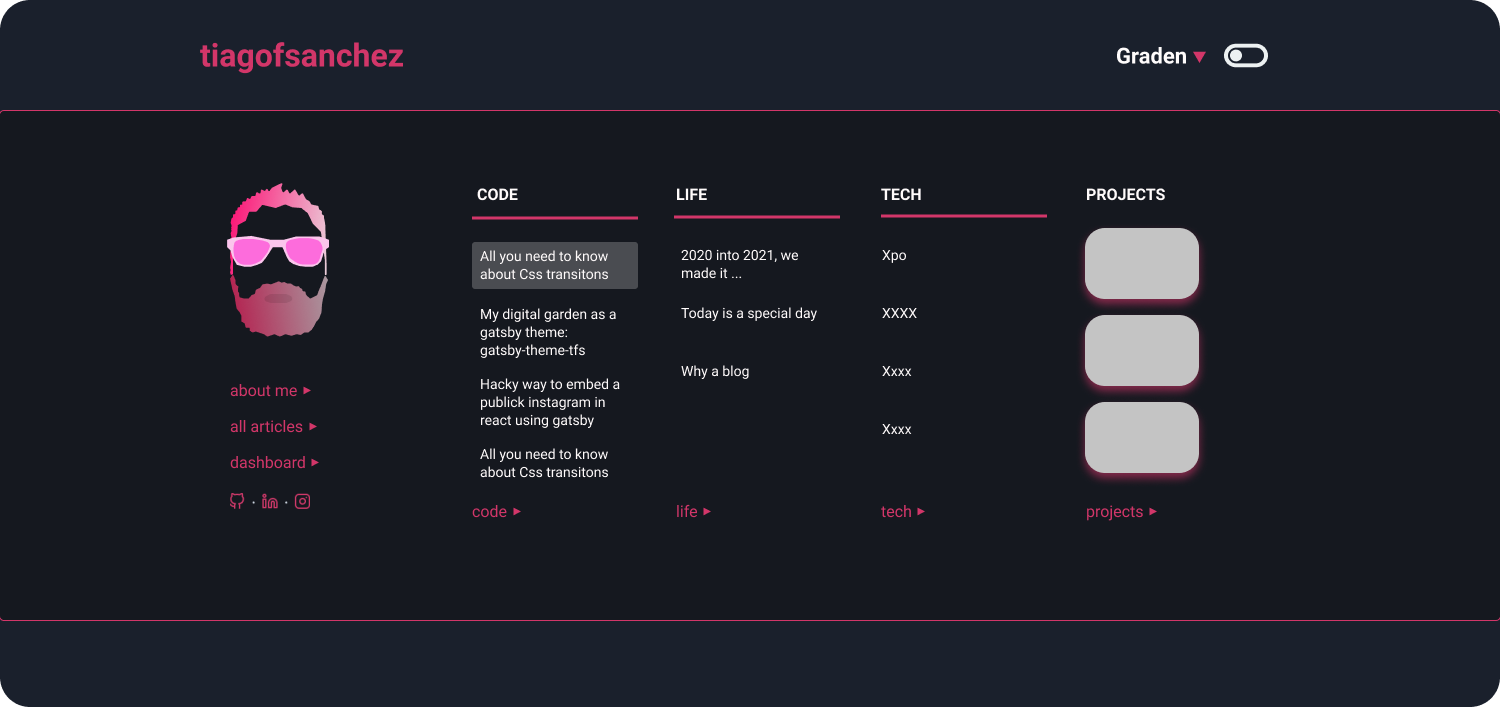Shadowing a Gatsby Theme
August 23, 2019 . 6 min read
blog
gatsby
react
This is, I hope, one of many posts where I will try to explain the challenges of setting a very simple blog with Gatsby from a newbie perspective. The purpose of this is to share learnings that hopefully will help anyone that is trying to do something similar, and of course, for me to learn as much as possible.
A big caveat, this is not, neither intends to be a tutorial, rather a cheat sheet that will enable anyone to solve for similar problems.
Using Gatsby gatsby-theme-blog
Still unclear with the reason why I am using gatsby-theme-blog over gatsby-starter-blog, but hey, I have chosen that path, probably because of
this post from Kyle, and now I am trying to make a couple of changes to the gatsby-theme-blog itself
so that I can provide a better experience for anyone reading it.
The theme looks great, it is simple, and it works like a dream.

Really love the way I can have a toggle that lets users change from into dark and day theme at the UI level. That is just fantastic.
However there are a couple of things are missing, such as:
- the timeToRead detail information is not there;
- any tags or blog posts categories (do they even exist?) don't exist;
- would be great to have a header with the different categories for this blog, that are as follows: ✍️ learning to code (front-end-development in React); 🏃 getting outside my comfort zone with running;💡 innovation and fintech related topics; ✈️ travelling with my family;
The above is more like a wish list that I will be working through as I will try to build that into my blog as I learn to code. So let's start with (1) and see how can we tackle this topic.
Enter Shadowing
To change something in gatsby-theme-blog, you will need to shadow the component of your theme and in my specific case, I will need to shadow posts.js file so that you can get the information that you want to in a way that you pass it to you DOM.
You can easily find posts.js on on your your file structure /node_modules/gatsby-theme-blog/src/components/posts.js. Once you are there, just copy and past it into your theme file structure on the following folder /src/gatsby-theme-blog/components/. You should expect to get the following:
import React, { Fragment } from "react";import { Link } from "gatsby";import { Styled, css } from "theme-ui";import Layout from "../components/layout";import SEO from "../components/seo";import Footer from "../components/home-footer";const Posts = ({ location, posts, siteTitle, socialLinks }) => ( <Layout location={location} title={siteTitle}> <main> {posts.map(({ node }) => { const title = node.title || node.slug; const keywords = node.keywords || []; return ( <Fragment key={node.slug}> <SEO title="Home" keywords={keywords} /> <div> <Styled.h2 css={css({ mb: 1 })} > <Styled.a as={Link} css={{ textDecoration: `none` }} to={node.slug} > {title} </Styled.a> </Styled.h2> <small>{node.date}</small> <Styled.p>{node.excerpt}</Styled.p> </div> </Fragment> ); })} </main> <Footer socialLinks={socialLinks} /> </Layout>);export default Posts;After that you will need to change the endpoint where you are importing the components from:
import Layout from "../../../node_modules/gatsby-theme-blog/src/components/layout";import SEO from "../../../node_modules/gatsby-theme-blog/src/components/seo";import Footer from "../../../node_modules/gatsby-theme-blog/src/components/home-footer";You can see that, after making the changes,if you console.log(posts), you will not get the timeToRead data point that I wanted, neither anything else to be honest! That is a bit of a problem.
We need to bring that in using GraphQL and do a couple of changes to my newly copied file. As I mentioned the first thing that I need to do is create a query that will bring me that information.
const data = useStaticQuery( graphql` query { allMdx(sort: { fields: [frontmatter___date], order: DESC }) { nodes { timeToRead frontmatter { date(formatString: "MMMM Do, YYYY") title } } } } `);I have use sort: here to make sure that both posts and our new variable data have the same order. So now that I have 2 data sets, (1) posts with all the details of the posts and (2) data with timeToRead, how can I join them in a way that I could .map() them into my JSX?
Merging data sets in JavaScript
First of all, before thinking about merging any data set, it is good to understand that we will have tow types of that sets, an ARRAY [] and a OBJECT {}.
Actually the posts array, will be an array of objects [node:{},node:{},node:{}] and the object will be something like this {nodes:[{},{},{}]}. So we will need to get the newly created data object in the same format as the posts array.
- Transforming the object into an array:
//this is probably the most difficult way to do it.const dataToArray = Object.keys(data.allMarkdownRemark.nodes).map(index => { let time = {}; time = data.allMdx.nodes[index]; return time;});//you can just deconstruct your objectconst { nodes } = data.allMarkdownRemark;- Creating a newPosts constant with all the posts:
const newPosts = posts.map(({ node }) => { let wipPost = { ...node }; return wipPost;});So now we do have 2 arrays like this [{A},{B},{C}] and [{a},{b},{c}], so how do we merge them together so we could have this [{A,a},{B,b},{C,c}]? If I wanted to get [{A},{B},{C},{a},{b},{c}] that would be very simple and I would use the spread operator.
However, that is not the case so we will need to do something a little bit different.
- Merging the newly created data sets:
const newData = dataToArray.map((data, index) => { let wipData = { ...data, post: newPosts[index] }; return wipData;});And that was exactly what I wanted to have.

As you can see I did made a couple of changes that are not described in here, but I think you get the gist.
What was also interesting, while I was going through this exercise, was to reflect if this was the best way to make the changes, or should I do them at the gatsby-theme-blog level? For now the question remains.
Another afterthought on the back of this are a couple of entries on the wishlist to improve the blog
The blog wishlist
- ✅ the timeToRead detail information is not there;
- any tags or blog posts categories (do they even exist?) don't exist;
- would be great to have a header with the different categories for this blog;
- styling topics:
- bullet points with less space
- break after the code snippet
- size of the fonts on code snippet smaller
- code snippet wider than the body text
- blockquote with a pink lateral line
- ...
- comments "plug in"
- a form for readers to subscribe;
- ...
There seems to be a lot of work to do...and lots more to learn.
Cheers! And see you around!
More posts about Code
Deploying Keystone-6 with Render
1 minutes read
Paginating through cards in NextJS not changing the url
1 minutes read
Thinking how to fetch data in nextjs
3 minutes read
Learning Advanced React with Wesbos
4 minutes read
Designing and implementing a megamenu in my digital garden
3 minutes read
All you need to know about CSS transitions
2 minutes read
Subscribe
No spam! Only good stuff!






